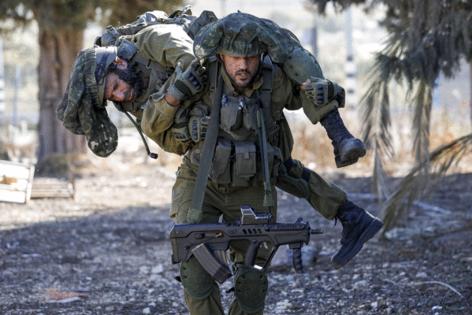Wartime medical innovations slash Israel's troop mortality rate
Published in News & Features
Custom-designed helmets that stave off major brain injuries. Mobile blood banks and preliminary surgery on the battlefield. Dog tags that broadcast medical data. Evacuation by helicopter to hospitals, measured in minutes. Fentanyl lollipops to ease the pain.
As Israel plows into the second year of open-ended war on several fronts, its military doctors have been innovating trauma care on the fly and grimly boast a record survival rate. That, in turn, may help shore up public support in Israel for a conflict that has inflicted the country’s worst losses in decades.
“We accrue battlefield knowledge and apply it and improve on it even as the fighting continues,” said Lt.-Col. Ofer Almog, head of technological development for the Israel Defense Forces (IDF) Medical Corps.
The human cost on the other side has been devastating — 44,000 dead in Gaza and 3,000 in Lebanon, many of them civilians.
Of Israeli soldiers who sustain wounds in the Gaza Strip or southern Lebanon that require urgent treatment, 6.9% die, the corps says - a “case fatality rate” (CFR) less than half that of Israel’s last major war, in 2006. It also compares favorably to the CFRs that U.S. forces suffered from similar kinds of attacks in Iraq and Afghanistan - 10% and 8.6%, according to a 2019 study published by the U.S. military’s Joint Trauma System.
An inherent advantage the Israelis have is in the proximity of hospitals. The average time it takes to evacuate a Gaza casualty to a trauma center is 66 minutes, the corps says. The record was 17 minutes.
But intervention begins beforehand, sometimes within seconds of the injury, administered by doctors, paramedics or medics deployed with every IDF combat company. Not far behind is an armored ambulance equipped with a specially cooled blood-bank, for type-O transfusions in large quantities to counteract catastrophic hemorrhaging.
“Our staff in the field are even equipped to do intraosseous infusions - directly into the bone marrow - when a soldier’s veins aren’t accessible,” Almog said.
Kyle Remick, a retired U.S. Army colonel and now trauma chief at Meritus Medical Center in Hagerstown, Maryland, described such “scoop and run” evacuations and rapid hemorrhage control as critical factors in saving lives.
“Unprecedented”
He called a CFR of 6.9% unprecedented, and noted that Israel has long been known as a leader in such battlefield care.
Israel has lost almost 800 soldiers, with another 5,350 wounded, in the war that began with a surprise Hamas cross-border rampage in October. On a per capita basis, that’s almost four times the number of U.S. service members killed in Iraq and Afghanistan. And unlike the professional U.S. military, Israel’s personnel are mostly conscripts and reservists. The Hamas attack killed 1200 and abducted 250.
Public support for the war in Israel has been strong, with some slippage only in recent weeks amid a sense that objectives in Gaza and Lebanon have been exhausted, said Tamar Hermann, a pollster with the Israel Democracy Institute think-tank.
“Had there been many hundreds of fatalities, the erosion would have begun earlier, I think,” she said.
Among the IDF’s wartime improvements to care, Almog said, has been a chip-bearing dog tag given immediately to a casualty, into which medics enter information through tablet-like devices. That smooths the handover from battlefield to helicopter to hospital, as each new team downloads the data.
Ease breathing
During the conflict, the IDF also stopped routinely draining excess air or fluid from a casualty’s chest to ease breathing, a procedure known as a thoracotomy.
“We determined, after investigating hundreds of cases, that there was zero proven utility that would suffice to counterbalance the potential damage,” Almog said. Two months into the war, the IDF limited the procedure and instead focused on methods like intubation and ventilation.
An IDF innovation team partnered with the Medical Corps is working on body armor that would give more protection than the ceramic breast plates currently issued to soldiers. The new design would incorporate malleable material and mitigate various penetrating injuries.
“We found that shrapnel wounds are six times more likely than bullet wounds,” Almog said.
The IDF already had its own battle helmet deployed, which the Medical Corps developed by studying head wounds and realizing that the most lethal were generally to the upper parts of the skull. Accordingly, the helmet has more plating over those areas and less elsewhere, for improved protection with roughly the same overall weight.
Mental acuity and alertness also play a role in survival. Instead of injecting morphine to dull the pain of an injury, a fentanyl lollipop is given which the casualty can remove when the pain is tolerable and thus remain responsive and cooperative with medics. Upon landing at the hospital, an assistance officer phones one of the casualty’s parents and has them speak directly and briefly about the injury - to provide a measure of calm as the patient enters surgery.
©2024 Bloomberg L.P. Visit bloomberg.com. Distributed by Tribune Content Agency, LLC.







Comments